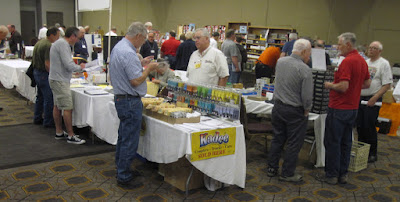If you are a tank car enthusiast, as I am, or if you just want to have a few realistic loads in the tank cars you operate, obviously you need to know something about what is carried in different sizes and ownerships of tank cars. Now petroleum products are easy, because much of that traffic moved in oil company tank cars (and UTLX cars serving the former parts of Standard Oil). But chemicals are another matter. What was in which cars, and where did they originate?
In my own case, I am interested in these questions as part of the process of compiling waybills, from prototype lists of shippers and receivers whenever possible, through prototype research otherwise. I have often found myself using Google, first to find a correct company name for my 1953 modeling year (like all corporations, chemical companies merge or split or are renamed from time to time), then further researching to find out where the company had its production plants or refineries, then to find out the principal products of that company and plant. Sometimes I start at the other end, knowing what one of my on-line industries would need to receive, then searching to find out where that product might come from.
Some of this process has been alluded to in previous posts (for example,
http://modelingthesp.blogspot.com/2011/09/content-of-waybills.html , and also the follow-up to that post, at:
http://modelingthesp.blogspot.com/2011/10/content-of-waybills-2.html ). But those posts, from back in 2011, were aimed at the more general question of waybills for all kinds of cargo. The present post is aimed specifically at tank cars and their cargoes.
As I’ve worked particularly on tank car issues more recently, I have found that Google searches repeatedly directed me to the same book, which is a history of chemical companies up to the year 2000, and finally realized that much of the research I was doing, on company names, plants, and products, could
all be found in this book. So I bought a copy. It’s by Fred Aftalion, is still in print, and can be bought on-line, used or new, from Amazon, Barnes & Noble, and a number of other booksellers, and even new from the publisher direct (Chemical Heritage Press, Philadelphia). Here is the cover of the softbound second edition:
I cannot say enough about this book. Phenomenally rich in information, at just the right level of detail for tank car cargoes and car choices, and worth way more to me than the $24.95 price. It does contain extensive information about European companies too, but the U.S. information, including oil companies, is just excellent.
From this book, I could much more quickly and conveniently discovered the history of Allied Chemical, which I laboriously teased out from several sources (my findings are here:
http://modelingthesp.blogspot.com/2012/10/small-modeling-project-icc-104-tank-car.html ). And that’s just one example.
How do you connect the company and product information to tank cars? It is very helpful to have at hand Ed Kaminski’s two books (published by Signature Press),
American Car & Foundry Company, 1899–1999, with a long chapter on tank cars but unfortunately now out of print, and
Tank Cars of American Car & Foundry Company, 1865–1955, published in 2003. These two books contain a great many builder photos. The second one,
Tank Cars, also contains a multi-page table in the back of the book, showing which cargoes could be carried in which cars.
Below are a few examples, taken from part of one page in this table, and you can see at once that some cargoes can be carried in a variety of cars, others are much more restricted. The first column tells you the regulatory identity of the cargo, which in turn determines the placard to apply. (You can click to enlarge these tables.)
The symbols in this table are in the key below.
To choose two examples, common chemicals such as nitric acid and napthalene are in the table portion shown, and their status identified. Napthalene is listed as “N.R.,” meaning non-regulated, and thus can move in the simplest kinds of cars, even the non-ICC-regulated cars such as AAR 203W, and without any placard. The complete table is thus a handy way to match up tank car types with waybilled cargoes and with the appropriate placards for those cargoes.
I’ve discussed tank car placard use before, both model and prototype (see:
http://modelingthesp.blogspot.com/2012/03/tank-car-placards-modeling.html ), and also gave in that post an introductory discussion of use of the table material shown above.
It’s also worth mentioning that there was some seasonality in tank car cargoes in the 1950s. We naturally expect seasonality in things like produce harvest (see for example my post on this topic, which can be found at:
http://modelingthesp.blogspot.com/2015/09/seasonality-of-crops-and-traffic.html ), but the same applies, in a lesser degree to tank cars. For example, asphalt for road repair moved much more heavily in late spring and summer than the rest of the year; home heating oil was very heavy in fall, as was LPG, as homeowners prepare for winter. Gasoline is heavier in the warmer months, and so on. To illustrate, here are data from 1948, by quarter, taken from Table N in the publication
The Tank Car Story, Defense Transportation Administration, Washington, DC, November 1, 1951. This publication presents a study of tank car availability with respect to military needs during the Korean war.
You can readily see that asphalt and gasoline are quite seasonal, in contrast to soybean oil, deliberately chosen as a nearly non-seasonal commodity for comparison, while cottonseed oil does show seasonal variation in parallel with cotton harvest season.
In creating and using tank car waybills on my layout, I have taken advantage of the kinds of information shown in this post. I commend these sources to anyone interested in doing the same.
Tony Thompson












































